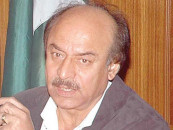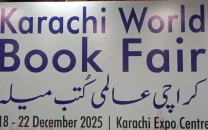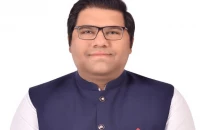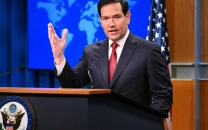Infant mortality: The lost children of Thar
Elusive healthcare facilities leave parents scrambling to save their offspring

Poor health and nutrition among Tharparkar residents has resulted in 326 deaths in 2014 and 398 deaths of children under the age of five in 2015. Media reports and NGOs, however, put the death toll as much as 1,600 in three years. PHOTO: ATHAR KHAN/EXPRESS
For three-month-old Kavita’s parents, the 200-kilometre journey from Lobar village to District Headquarters Hospital, Mithi, was one on which depended their infant’s life. However, once they got there, the doctor on duty refused to admit their ailing daughter, pronouncing her dead on arrival.
This prompted members of the Bheel community, to which the bereaved parents belong, to protest against the hospital’s administration. Kavita’s father, Chetan, believes the delay in her treatment led to her death. Chetan says he is not the only one to have lost a child due to the negligence of doctors at the hospital. Hundreds of children in Thar have lost their lives because they were not provided timely medical attention.
Child mortality: Sindh CS told to file Thar deaths report
Over 100 children have died in January alone, according to media reports. “The government is only relying on hospital data. There is no record of those who died in faraway villages,” says Kathau Jani, a journalist based in Mithi. In fact, eight children were discharged from the hospital last week even though they were in critical condition. Of these eight children, four died on their way back home, he claims.

Government record shows 326 deaths in 2014 and 398 deaths of children under the age of five in 2015. Media reports and NGOs, however, put the death toll considerably higher: as much as 1,600 in three years.
According to a doctor at the hospital, children in critical condition are referred to hospitals in Karachi and Hyderabad. Sometimes, however, their parents refuse to oblige. He adds there are several instances of children dying on the way to the hospital or doctors refusing to take them in due to their critical condition. These doctors claim parents only bring their children to the hospital when nothing more can be done. “There is a need to prepare our colleagues as well,” he, however, admits.
Geography has a significant role to play in delays in getting medical attention. Over 90% of Thar’s people live in scattered villages. There are only six main cities in the district, with over 2,380 villages, according to official records. “The travelling cost from the village of Kasbo to Mithi is Rs6,000. How can a poor family afford such an expensive journey? questions Ejaz Bajeer, a local journalist.
Kavita’s parents, too, could not afford to make the trek sans financial assistance, but a local NGO, Hands, provided them a car to take them to Mithi. “The price hike in essential medicines further restricts us from referring children to hospitals,” explained Bajeer.
A report published in 2014 by the UN Office for the Coordination of Humanitarian Affairs states limited access to health services and a severe drought has led to a ‘nutrition crisis’ in the region.

At present, there are only 21 specialists for Thar’s population of 1.3 million and a two-room, 90-bed civil hospital in Mithi. There is, however, no child ward, let alone any children’s hospital. According to the Mithi administration, there are 189 dispensaries in the region, of which 80 are dysfunctional.
Locals contest, however, the claims, saying even the remaining health facilities are out of order. They even claim to have a list of over 150 dispensaries that were shut down by the government and never reopened. Moreover, posts of around 300 doctors are lying vacant.
Dr Mohan Lal Khatri, the lone child specialist in Mithi, says other factors also feature significantly in Thar’s abysmal child mortality rate. “A majority of married couples have an average of eight to ten children,” he says, adding lack of hygiene is a major concern. “Since these are poor kids coming from poor families, they don’t have the awareness to wash hands and remain clean.”
According to him, other reasons include birth asphyxia, respiratory distress syndrome, pneumonia and delivery of babies through traditional birth attendants, which often results in neonatal sepsis and diarrhea.
Thar deaths: Provincial govt to nominate members for judicial commission
Mithi Commissioner Shafiq Ahmad says efforts are under way to make health facilities functional again. “The geography of the area is the main hurdle in ensuring health facilities. It just isn’t practically possible to extend such facilities at people’s doorsteps.”
All’s well at CM House
Sindh Chief Minister Qaim Ali Shah remains unnervingly nonchalant. “Problems exist everywhere - from Karachi to Kashmore and Tharparkar,” he said at a recent news conference at CM House in Karachi. “But the way in which the government is being targeted is regrettable.”
Shah’s adviser Maula Bux Chandio also claimed the media was targeting Pakistan Peoples Party unfairly. “The government is only responsible for deaths that take place in the hospital. How can the government be responsible if someone dies far away in the sand dunes?”
Published in The Express Tribune, February 2nd, 2016.



















COMMENTS
Comments are moderated and generally will be posted if they are on-topic and not abusive.
For more information, please see our Comments FAQ